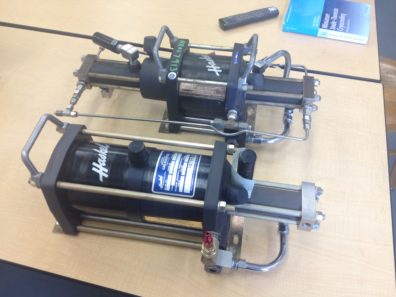
Left to Right: Cameron Stone – Greg Wallace – Nathaniel Jones – Riley Howard – Will Wilber
Compressors have been the Achilles heel of hydrogen refueling stations worldwide. Our team intends to change that. Instead of a typical 10,000 psi compressor we are going after a reasonable 1400 psi. This is attainable thanks to our patent pending vortex tube system.
Background
One of the biggest faults in previous hydrogen refueling stations has been the compressors. To pack enough hydrogen into a small tank, hydrogen powered cars use high pressure gas tanks as storage. Current models of cars use 10,000psi tanks, so refueling stations must produce hydrogen hydrogen at that pressure. Conventional stations use only compressors to achieve this. But at such high pressure, mechanical failures are common, causing excessive down time and costly repairs. Our method of compression through liquefaction is intended to minimize this risk by using low pressure compressors. The compressors drive the liquefaction process, providing enough pressure for the vortex tube and throttle valve to operate. These will liquefy the hydrogen which can be boiled to produce pressures even higher than 10,000psi.
Compression Methods
Most hydrogen compressors (especially for refueling stations) operate via piston, scroll, or diaphragm. The various types of compressors and their advantages are as followed:
Piston Compressor [More Info] – Uses a piston to compress fluid. A design that has been tried again and again, and that can be made as simple or complex as needed. They are efficient and can be made in large sizes, but tend to be costly and have many moving parts.

Diaphragm Compressor [More Info] – Instead of a piston, this uses a flexing diaphragm to manipulate pressure. Metal-based diaphragms are low volume but high pressure. Rubber/Silicone diaphragms are high volume, low pressure and need replacement often. The drive fluid can be lubricated without risking contamination of the working fluid.
Scroll Compressor [More Info] – Uses one fixed and one moving spiral. The moving spiral orbits the other, but does not rotate, to push fluid against the non-moving spiral to create suction and compression. These are quiet, smooth, and reliable, especially at lower volumes. They have fewer moving parts but are highly susceptible to debris (which should not be present in our system).
Centrifugal Compressor [More Info] – Use a high speed impeller and a diffuser to increase the pressure of a gas. These are similar to gas blowers, but operate at much higher velocities and pressures.
Ionic Liquid Piston Compressor [More Info] – Acts similarly to piston compressor, but uses an ionic liquid rather than a metal piston. These have very few parts and are long lasting. These produce very little waste heat.
Electrochemical hydrogen compressor [More Info] – Uses electricity to separate hydrogen into protons and electrons and force them across a membrane. They can maintain high pressure, are compact, uses no moving parts, and has good efficiency.
Hydride Compressor [More Info] – Absorbs hydrogen ions at low temperature and pressure and expels them at high pressure when heated. High volume flow rate with no moving parts, but are expensive and heavy and high amounts of produce waste heat.
Gas Booster [More Info] – Takes compressed air and creates compressed gas through pneumatics. A large cylinder is actuated with 90psi air. This pushes on a smaller piston for the working gas. Since force = pressure x area, the smaller piston creates a higher pressure than that which was applied on the larger one, at the expense of flow rate. This requires a large volume of compressed air, but is cheaper to buy than an specialized hydrogen compressor.
Some compressor systems have been studied and tested to great lengths. Others are barely in research and development. Since we will not have the time or funding to create a compressor from scratch, we are limited to more established methods of compression: piston, scroll, diaphragm, or centrifugal. The most efficient method for us is to chose a pre-developed compressor from a company that specializes in their construction.
Design Specifications
The compressor takes in hydrogen from two components: the “hot” gas expelled from the vortex tube and excess hydrogen from the storage tank. This injects the hydrogen back into the pre-cooling cycle and the vortex tube where it will be liquefied and then stored. To maximize system efficiency, the following are our requirements:
- 1400psi Output Pressure: The vortex tube requires a certain amount of pressure to operate at its highest efficiency. When the gas enters, it is forced into a spiral at high speeds. This high speed cannot be achieved without high pressure forcing it through the device. By calculating the ideal pressure for the vortex tube and adding in the pressure needed for throttling, we need about 1400psi.
- 1.5-5g/s (75-125 SCFM) Mass Flow Rate: Our system must produce 50 kg of liquid hydrogen each day. But we must also take into account the need to re-compress the waste gas from the hot end of the vortex tube and tank boil off. This gives us our required flow rate.
- Oil-Free: To ensure that no lubricants or oils leach into the hydrogen, we will use a compressor that uses no oil in the working space.
- Inexpensive: Funds are limited. The source and purification teams alone are expected to take up to half the budget.
- Dependable: Any time spent out of commission is money lost. The H2 Refuel Prize desires a system able to operate for 98% of the time.
- Compact: The entire space of the container is only about 600 cubic feet. The storage and the source groups are expected to take up about 400 cubic feet combined!
Design Options
Finding an adequate compressor within our budget has been difficult. Few pre-designed compressors fit our specifications. Instead, would most likely need

an expensive custom-built compressor. Until that problem is solved, we will focus on using gas boosters, which are already available for accomplishing our goals. For our proof of concept, we will use a lower flow rate than our initial plan, but this can be driven with two Haskel gas boosters we already own:
Haskel AGD-15 (Single Stage, Double Acting) – 1,400psi stall pressure
Haskel AG-152 (Single Stage, Single Acting) – 13,500psi stall pressure
Both were inherited by the HYPER lab after use in previous projects. They are being repaired to ensure safety and efficiency. While gas boosters are not as efficient as direct compression, they are currently available on the market and are cheap to buy. Until a compressor is found which fits all our needs, we will continue using gas boosters. The following are the compressor companies we have been in contact with:
RIX [RIX Industries] – Piston Compressors
Air Squared [Air Squared] – Scroll Compressors
Hydro-Pac [Hydro-Pac Inc.] – Piston Compressors
Sundyne [Sundyne] – Centrifugal and Diaphragm Compressors
What’s next?
With the hydrogen sufficiently compressed and the gas flowing as needed, it can finally move on to the next stages. All the output of the compressor will next go through a heat exchanger system to remove excess heat and then move on to the pre-cooling system.